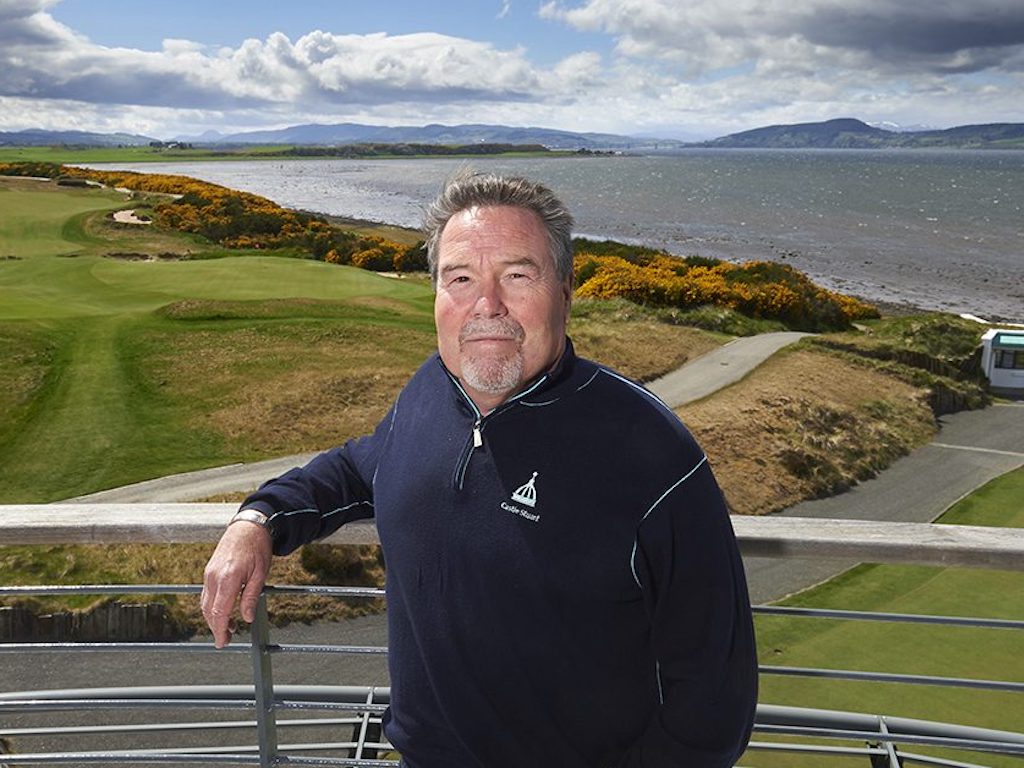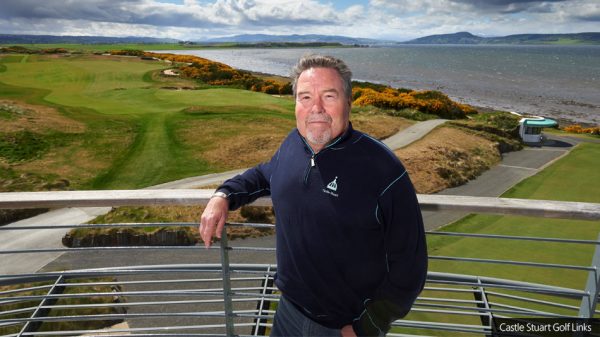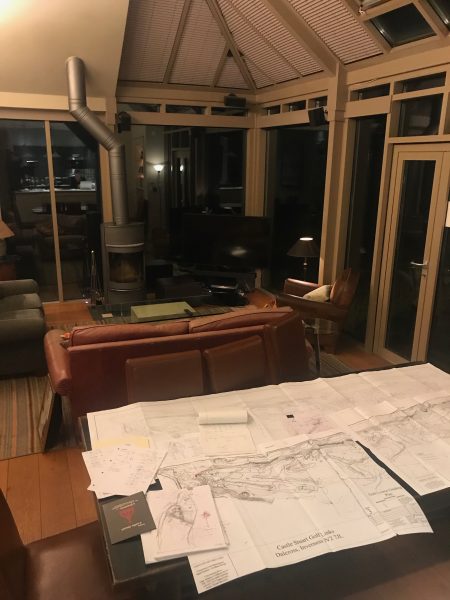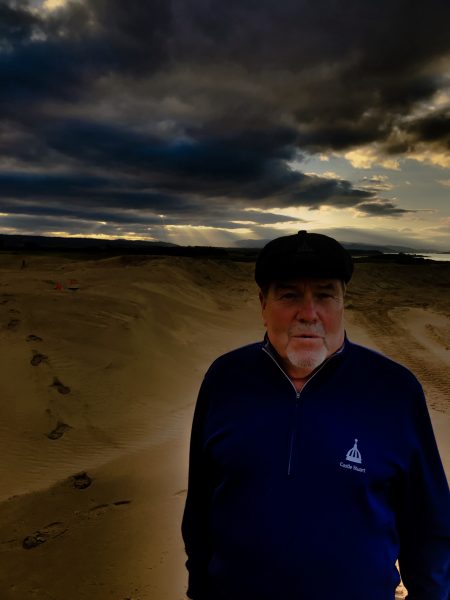Opinion & Analysis
Mark Parsinen: A friend’s tribute to a lesser known genius

Golf has always elevated course architects to exalted status. From Mackenzie, Ross and Tillinghast to Fazio, Jones (Robert Jr. and Rees), Hanse and Coore-Crenshaw, golf’s version of rock stars make their name in the dirt and are lauded by writers and players worldwide.
Similarly, patrons of the game like Johnny Morris have ascended in the industry as they have translated their financial fortunes and love of golf to facilitate the creation of destinations like Big Cedar Lodge; they are the Medicis of golf’s new Golden Age. But I can only think of only a few who combine the skill and sensibility of a great designer with the vision and passion of a great patron. One who is well-known is Mike Keiser. Although lesser-known, Mark Parsinen was another.
I was introduced to Mark Parsinen by another good friend, Robert Trent Jones Jr. Bobby had worked with Mark at Granite Bay; he knew that Mark was in Washington, DC for a family event and thought that we should meet. I met Mark in the lobby of his hotel along with his wife Dede, his daughter Jenny and a bunch of their friends, including the actor Taye Diggs. Someone wanted to get a picture of the family and I moved over to the side to make way. As they were forming up, Mark called to me, “Hey Michael, come join the picture!”
I had known him for all of five minutes and he insisted that I be a part of a shared memory. That was our friendship. That was Mark Parsinen.
Mark grew up in Minnesota, the son of Finnish immigrants. He liked to joke that while there were many Nordic immigrants in Minnesota, the Finns were the lowest in the pecking order. He maintained a sense of humility from his parents’ immigrant roots, but he also inherited a work ethic that would enable him to accomplish things that others could or would not. Work was not work for Mark; he liked the idea of every moment being spent purposefully. If something took fifteen minutes to do properly, so be it. If it was fifteen hours, fine. His gift was the ability to envision an outcome and progress towards it with a combination of stamina and joy.

He went to the London School of Economics and went on to become a partner in the Boston Group, one of the nation’s leading consulting firms. In his role with the Boston Group he had a hand in guiding a wide range of companies and products to success. A little-known fact I that he was instrumental in the creation of light beer; he laughed when I told him that was nothing to be happy about.
An accomplished player, Mark was self-trained in course design. He moved to the West Coast and wanted to join a club but couldn’t get a spot in any club that he liked so he built his own, Granite Bay Golf Club near Sacramento, California. It was his first golf course project, a collaboration with Jones, Jr. Said Bobby, “[Mark] didn’t know much about golf course design when we started working together, but I knew what he liked and wanted. The expertise came later.” Granite Bay won praise immediately and Mark was off and running.

Kingsbarns Golf Links
He is best known for his courses in Scotland, Kingsbarns (2000 with Kyle Phillips) and Castle Stuart (2009 with Gil Hanse). Both courses were heralded as among the world’s best courses virtually from the moment of their opening. After playing Castle Stuart, Phil Mickelson was so impressed that he said that it should be studied by anyone who is planning to build a golf course before they turned a shovel of earth.

Castle Stuart Golf Links
Mark’s genius was the ability to work with the best golf architects in the world and challenge them to greatness. He taught himself to be able to read topographical maps and to understand soil samples (skills he encouraged me to acquire). He came to master the art, science, logistics and the operations of a golf course; of course, he had quality people around him who specialized in their expertise, but Mark had a knack for taking something known, tilting it and saying “Could it be better this way?”. To Mark, the world was a big kaleidoscope, and he was fascinated by how you could make something beautiful just by looking at it differently.
His legacy, along with his family, will certainly be or the golf courses that he built. They are treasures that will only grow in stature very time. But what I know from the hours we spent talking about golf and golf courses is that he loved golfers even more than he loved golf courses. His primary influence for golf course design was the Old Course at St. Andrews, a course that he and played over 200 times in his life. He wrote eloquently about the Old Course:
“I have become a devotee of the Old Course where I’ve come to see the golf experience there as definitely not a sequence of tests, but rather a sequence of opportunities to decide whether or not to take risk to gain an advantage with a subsequent shot or to defer the risk by playing a safe shot thereby taking on a greater risk and challenge with a subsequent shot – AND at the same time, the Old Course seems to allow players the freedom to find their own path to the green to suit their own game and their own propensities. I’ve come to cherish this type of experience in contrast with having to face a sequence of pre-determined tests where one’s game may or may not be suited to the challenge that must be confronted with little or no option or likelihood of success. Being the prisoner of a narrowly defined path can often feel quite oppressive compared with the freedom of a more open playing field with many avenues to the green available for evaluation and selection.”

The Old Course at St. Andrews
Mark wanted golf to be a challenge, not a double-dog dare. His courses represent his reverence for the principles of the Old Course and a genuine affection for the golfer and the quality of their experience. We had much fun one day with his theory that there were Catholic courses and Protestant courses. Catholic courses were like St. Andrews, where you could make huge mistakes but there was almost always a chance for redemption. Carnoustie was a Protestant course, where the path to success was straight and narrow, and mistakes were severely punished. It was the kind of intellectual exercise that Mark loved because there was no right or wrong, just a liberating exchange of ideas and information.
The last time I saw Mark was when I visited him at his home in Inverness on the 14th hole at Castle Stuart. We spent the final day of the trip surveying the work that was being done on the new 9-hole course at Castle Stuart, which had not yet been completed. We sifted through handfuls of sand to determine their density; like any good golf course designer, Mark loved dirt. He explained the dozens of flags that were placed in the ground to guide the bulldozers and shapers.
At one point, he was explaining the shape of the surrounds of a green when he turned to me and asked, “What do you think?” I was reluctant at first to give voice to a thought lest it be rejected or even ridiculed. After some prompting, I gave him my thoughts on the severity of slope on one side of a green. He looked at the green, then looked at me and smiled broadly. “You are right…that makes sense.” He flagged down one of the lads on a shaper and shared my thoughts. “Michael, we’ll have to get you on a tractor when we do the next eighteen.” I couldn’t have been prouder if I had won the Open Championship.

Construction on the 9-hole course at Castle Stuart
Mark was surrounded in his life by people who were devoted to him. Our final night in Scotland we made dinner at home and drank local gin (me) and red wine (him) along with Elspeth, the Food and beverage Manager at Castle Stuart who has become as essential to the course as the tee markers and flagsticks. We talked about everything from our favorite golf courses to the people that had shaped our lives. We laughed until the wee hours and next day, Mark and I made our way back to the States. We talked many times after that; just last week he had invited me to come spend time with him and the family at their vacation home in Nevada. “Dede and everyone would love to see you,” he said, “and we can go play some golf and talk about what we can do together.” We did have plans; for books, for films, for new courses. So many plans…

His study in Inverness
Mark was 70 years old and a very accomplished man, but he was in many ways just getting started. He built Granite Bay, Kingsbarns, and Castle Stuart. He was an intellectual, a visionary and a raging success at everything he did. He loved golf, but more importantly he loved golfers and did everything he could to make sure that his properties were fun on the course and off. He was a devoted husband to his beloved wife Dede and exemplary father to his children. He leaves behind a host of people in the golf industry who admired and respected him. He was my mentor and my friend. We saw golf and life in very much the same way. I am heartbroken. I will miss him so very much.
- LIKE64
- LEGIT2
- WOW14
- LOL0
- IDHT1
- FLOP0
- OB0
- SHANK0
19th Hole
Vincenzi’s 2024 Zurich Classic of New Orleans betting preview

The PGA TOUR heads to New Orleans to play the 2023 Zurich Classic of New Orleans. In a welcome change from the usual stroke play, the Zurich Classic is a team event. On Thursday and Saturday, the teams play best ball, and on Friday and Sunday the teams play alternate shot.
TPC Louisiana is a par 72 that measures 7,425 yards. The course features some short par 4s and plenty of water and bunkers, which makes for a lot of exciting risk/reward scenarios for competitors. Pete Dye designed the course in 2004 specifically for the Zurich Classic, although the event didn’t make its debut until 2007 because of Hurricane Katrina.
Coming off of the Masters and a signature event in consecutive weeks, the field this week is a step down, and understandably so. Many of the world’s top players will be using this time to rest after a busy stretch.
However, there are some interesting teams this season with some stars making surprise appearances in the team event. Some notable teams include Patrick Cantlay and Xander Schauffele, Rory McIlroy and Shane Lowry, Collin Morikawa and Kurt Kitayama, Will Zalatoris and Sahith Theegala as well as a few Canadian teams, Nick Taylor and Adam Hadwin and Taylor Pendrith and Corey Conners.
Past Winners at TPC Louisiana
- 2023: Riley/Hardy (-30)
- 2022: Cantlay/Schauffele (-29)
- 2021: Leishman/Smith (-20)
- 2019: Palmer/Rahm (-26)
- 2018: Horschel/Piercy (-22)
- 2017: Blixt/Smith (-27)
2024 Zurich Classic of New Orleans Picks
Tom Hoge/Maverick McNealy +2500 (DraftKings)
Tom Hoge is coming off of a solid T18 finish at the RBC Heritage and finished T13 at last year’s Zurich Classic alongside Harris English.
This season, Hoge is having one of his best years on Tour in terms of Strokes Gained: Approach. In his last 24 rounds, the only player to top him on the category is Scottie Scheffler. Hoge has been solid on Pete Dye designs, ranking 28th in the field over his past 36 rounds.
McNealy is also having a solid season. He’s finished T6 at the Waste Management Phoenix Open and T9 at the PLAYERS Championship. He recently started working with world renowned swing coach, Butch Harmon, and its seemingly paid dividends in 2024.
Keith Mitchell/Joel Dahmen +4000 (DraftKings)
Keith Mitchell is having a fantastic season, finishing in the top-20 of five of his past seven starts on Tour. Most recently, Mitchell finished T14 at the Valero Texas Open and gained a whopping 6.0 strokes off the tee. He finished 6th at last year’s Zurich Classic.
Joel Dahmen is having a resurgent year and has been dialed in with his irons. He also has a T11 finish at the PLAYERS Championship at TPC Sawgrass which is another Pete Dye track. With Mitchell’s length and Dahmen’s ability to put it close with his short irons, the Mitchell/Dahmen combination will be dangerous this week.
Taylor Moore/Matt NeSmith +6500 (DraftKings)
Taylor Moore has quickly developed into one of the more consistent players on Tour. He’s finished in the top-20 in three of his past four starts, including a very impressive showing at The Masters, finishing T20. He’s also finished T4 at this event in consecutive seasons alongside Matt NeSmith.
NeSmith isn’t having a great 2024, but has seemed to elevate his game in this format. He finished T26 at Pete Dye’s TPC Sawgrass, which gives the 30-year-old something to build off of. NeSmith is also a great putter on Bermudagrass, which could help elevate Moore’s ball striking prowess.
- LIKE8
- LEGIT3
- WOW1
- LOL1
- IDHT0
- FLOP3
- OB1
- SHANK1
19th Hole
Vincenzi’s 2024 LIV Adelaide betting preview: Cam Smith ready for big week down under

After having four of the top twelve players on the leaderboard at The Masters, LIV Golf is set for their fifth event of the season: LIV Adelaide.
For both LIV fans and golf fans in Australia, LIV Adelaide is one of the most anticipated events of the year. With 35,000 people expected to attend each day of the tournament, the Grange Golf Club will be crawling with fans who are passionate about the sport of golf. The 12th hole, better known as “the watering hole”, is sure to have the rowdiest of the fans cheering after a long day of drinking some Leishman Lager.
The Grange Golf Club is a par-72 that measures 6,946 yards. The course features minimal resistance, as golfers went extremely low last season. In 2023, Talor Gooch shot consecutive rounds of 62 on Thursday and Friday, giving himself a gigantic cushion heading into championship Sunday. Things got tight for a while, but in the end, the Oklahoma State product was able to hold off The Crushers’ Anirban Lahiri for a three-shot victory.
The Four Aces won the team competition with the Range Goats finishing second.
*All Images Courtesy of LIV Golf*
Past Winners at LIV Adelaide
- 2023: Talor Gooch (-19)
Stat Leaders Through LIV Miami
Green in Regulation
- Richard Bland
- Jon Rahm
- Paul Casey
Fairways Hit
- Abraham Ancer
- Graeme McDowell
- Henrik Stenson
Driving Distance
- Bryson DeChambeau
- Joaquin Niemann
- Dean Burmester
Putting
- Cameron Smith
- Louis Oosthuizen
- Matt Jones
2024 LIV Adelaide Picks
Cameron Smith +1400 (DraftKings)
When I pulled up the odds for LIV Adelaide, I was more than a little surprised to see multiple golfers listed ahead of Cameron Smith on the betting board. A few starts ago, Cam finished runner-up at LIV Hong Kong, which is a golf course that absolutely suits his eye. Augusta National in another course that Smith could roll out of bed and finish in the top-ten at, and he did so two weeks ago at The Masters, finishing T6.
At Augusta, he gained strokes on the field on approach, off the tee (slightly), and of course, around the green and putting. Smith able to get in the mix at a major championship despite coming into the week feeling under the weather tells me that his game is once again rounding into form.
The Grange Golf Club is another course that undoubtedly suits the Australian. Smith is obviously incredibly comfortable playing in front of the Aussie faithful and has won three Australian PGA Championship’s. The course is very short and will allow Smith to play conservative off the tee, mitigating his most glaring weakness. With birdies available all over the golf course, there’s a chance the event turns into a putting contest, and there’s no one on the planet I’d rather have in one of those than Cam Smith.

Louis Oosthuizen +2200 (DraftKings)
Louis Oosthuizen has simply been one of the best players on LIV in the 2024 seas0n. The South African has finished in the top-10 on the LIV leaderboard in three of his five starts, with his best coming in Jeddah, where he finished T2. Perhaps more impressively, Oosthuizen finished T7 at LIV Miami, which took place at Doral’s “Blue Monster”, an absolutely massive golf course. Given that Louis is on the shorter side in terms of distance off the tee, his ability to play well in Miami shows how dialed he is with the irons this season.
In addition to the LIV finishes, Oosthuizen won back-to-back starts on the DP World Tour in December at the Alfred Dunhill Championship and the Mauritus Open. He also finished runner-up at the end of February in the International Series Oman. The 41-year-old has been one of the most consistent performers of 2024, regardless of tour.
For the season, Louis ranks 4th on LIV in birdies made, T9 in fairways hit and first in putting. He ranks 32nd in driving distance, but that won’t be an issue at this short course. Last season, he finished T11 at the event, but was in decent position going into the final round but fell back after shooting 70 while the rest of the field went low. This season, Oosthuizen comes into the event in peak form, and the course should be a perfect fit for his smooth swing and hot putter this week.

- LIKE12
- LEGIT3
- WOW1
- LOL1
- IDHT0
- FLOP1
- OB1
- SHANK1
Opinion & Analysis
The Wedge Guy: What really makes a wedge work? Part 1

Of all the clubs in our bags, wedges are almost always the simplest in construction and, therefore, the easiest to analyze what might make one work differently from another if you know what to look for.
Wedges are a lot less mysterious than drivers, of course, as the major brands are working with a lot of “pixie dust” inside these modern marvels. That’s carrying over more to irons now, with so many new models featuring internal multi-material technologies, and almost all of them having a “badge” or insert in the back to allow more complex graphics while hiding the actual distribution of mass.
But when it comes to wedges, most on the market today are still single pieces of molded steel, either cast or forged into that shape. So, if you look closely at where the mass is distributed, it’s pretty clear how that wedge is going to perform.
To start, because of their wider soles, the majority of the mass of almost any wedge is along the bottom third of the clubhead. So, the best wedge shots are always those hit between the 2nd and 5th grooves so that more mass is directly behind that impact. Elite tour professionals practice incessantly to learn to do that consistently, wearing out a spot about the size of a penny right there. If impact moves higher than that, the face is dramatically thinner, so smash factor is compromised significantly, which reduces the overall distance the ball will fly.
Every one of us, tour players included, knows that maddening shot that we feel a bit high on the face and it doesn’t go anywhere, it’s not your fault.
If your wedges show a wear pattern the size of a silver dollar, and centered above the 3rd or 4th groove, you are not getting anywhere near the same performance from shot to shot. Robot testing proves impact even two to three grooves higher in the face can cause distance loss of up to 35 to 55 feet with modern ‘tour design’ wedges.
In addition, as impact moves above the center of mass, the golf club principle of gear effect causes the ball to fly higher with less spin. Think of modern drivers for a minute. The “holy grail” of driving is high launch and low spin, and the driver engineers are pulling out all stops to get the mass as low in the clubhead as possible to optimize this combination.
Where is all the mass in your wedges? Low. So, disregarding the higher lofts, wedges “want” to launch the ball high with low spin – exactly the opposite of what good wedge play requires penetrating ball flight with high spin.
While almost all major brand wedges have begun putting a tiny bit more thickness in the top portion of the clubhead, conventional and modern ‘tour design’ wedges perform pretty much like they always have. Elite players learn to hit those crisp, spinny penetrating wedge shots by spending lots of practice time learning to consistently make contact low in the face.
So, what about grooves and face texture?
Grooves on any club can only do so much, and no one has any material advantage here. The USGA tightly defines what we manufacturers can do with grooves and face texture, and modern manufacturing techniques allow all of us to push those limits ever closer. And we all do. End of story.
Then there’s the topic of bounce and grinds, the most complex and confusing part of the wedge formula. Many top brands offer a complex array of sole configurations, all of them admittedly specialized to a particular kind of lie or turf conditions, and/or a particular divot pattern.
But if you don’t play the same turf all the time, and make the same size divot on every swing, how would you ever figure this out?
The only way is to take any wedge you are considering and play it a few rounds, hitting all the shots you face and observing the results. There’s simply no other way.
So, hopefully this will inspire a lively conversation in our comments section, and I’ll chime in to answer any questions you might have.
And next week, I’ll dive into the rest of the wedge formula. Yes, shafts, grips and specifications are essential, too.
- LIKE32
- LEGIT7
- WOW1
- LOL1
- IDHT2
- FLOP3
- OB1
- SHANK3
-

 19th Hole2 weeks ago
19th Hole2 weeks agoDave Portnoy places monstrous outright bet for the 2024 Masters
-

 19th Hole3 days ago
19th Hole3 days agoJustin Thomas on the equipment choice of Scottie Scheffler that he thinks is ‘weird’
-

 19th Hole2 weeks ago
19th Hole2 weeks agoTiger Woods arrives at 2024 Masters equipped with a putter that may surprise you
-

 19th Hole3 days ago
19th Hole3 days ago‘Absolutely crazy’ – Major champ lays into Patrick Cantlay over his decision on final hole of RBC Heritage
-

 19th Hole3 weeks ago
19th Hole3 weeks agoReport: Tiger Woods has ‘eliminated sex’ in preparation for the 2024 Masters
-

 19th Hole1 week ago
19th Hole1 week agoTwo star names reportedly blanked Jon Rahm all week at the Masters
-

 19th Hole1 week ago
19th Hole1 week agoReport: LIV Golf identifies latest star name they hope to sign to breakaway tour
-

 19th Hole1 week ago
19th Hole1 week agoNeal Shipley presser ends in awkward fashion after reporter claims Tiger handed him note on 8th fairway






















Mike DiCarlo
Jun 10, 2019 at 9:23 am
Michael,
Great story about a terrific man. I can’t say that we are friends though it felt that way. For a six month period, we talked 3-4 times a week and those conversations usually lasted 90+ minutes. I looked forward to those conversations because they were always about golf but at the same time about life. He will be greatly missed. My best to his wife and children.
BJ
Jun 9, 2019 at 12:28 pm
Granite Bay is great. If your a club corp member its a must play
Sam
Jun 7, 2019 at 4:41 pm
Two great and fun filled Scottish courses. Nothing better after a round at Kingsbarns than sitting outside with a beer betting on whether a golfer playing the last would clear the burn. Sadly now pretty much out of our price range but it is now firmly on the tourists circuit, so fair enough. He always gave the impression of being a genuine person. Thanks
Jaime
Jun 7, 2019 at 3:13 pm
What’s Kyle Phillips going to do now?
Dave
Jun 6, 2019 at 2:56 pm
Great read and tribute! I’ll be more aware when I play Granite Bay in 11 days…